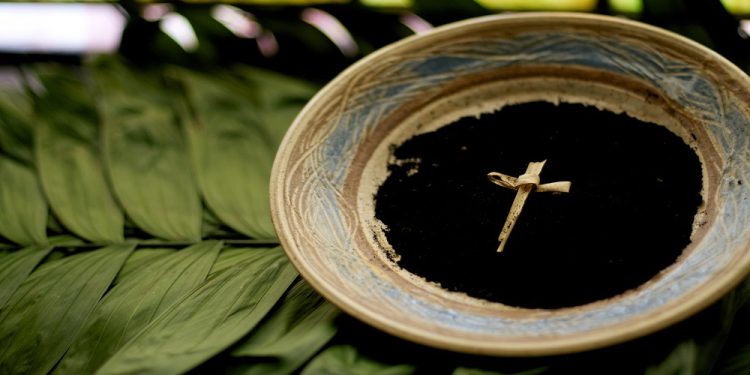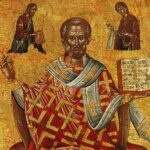
Ash Wednesday
Ash Wednesday is an integral part of the Lenten season in many Christian religions, including Catholic, Orthodox, and some Protestant denominations. Lent is a religious time period of 40 days before Easter Sunday, focusing on prayer, penance, and a renewal of faith. For the leap year of 2012, the number of days between Ash Wednesday and Easter Sunday totaled 45.
If the year is a non-leap year, the number of days between Ash Wednesday and Easter Sunday totals 44. There is a difference of approximately 6 days between the 40 days of the Lenten season and the actual count of 44 days (45 in a leap year). The difference lies in the history of the season of Lent.
History
During the first through third centuries, the Lenten season, or the season to prepare for Jesus’ rising from the dead, was in controversy. St. Irenaeus (who lived approximately in the second century) wrote a letter to Pope St. Victor I regarding the Lent fasting controversy among different factions of the Church.
He stated, “The dispute is not only about the day but also about the actual character of the fast. Some think that they ought to fast for one day, some for two, others for still more; some make their ‘day’ last 40 hours on end. Such variation in the observance did not originate in our own day, but very much earlier, in the time of our forefathers” (Eusebius, History of the Church, V, 24).
The discrepancies tended to cease during the fifth century when St. Leo (Pope from 440 A.D. to 461 A.D.) wrote that those of the Catholic faith should “abstain that they may ‘fulfill with their fasts the Apostolic institution of the forty days.'” St. Leo suggests that, in the years after the death of Jesus, the Apostles fasted for 40 days before each Easter Sunday (the day Jesus rose from the dead).
The 40-day fasting period is similar to the 40-day fasting period Jesus spent in the desert before beginning His ministry, as is stated in St. Matthew 4:1-2. There are controversies surrounding the exact time period in which the actual forty days of Lent began. It is noted, however, that by the time the Council of Nicaea in 325 A.D. gathered, there is a mention of the word “tessarakonta,” translated from Greek, meaning ‘forty’.
“For the first time in recorded history, we have mention of this period of preparation for Easter as lasting forty days.” The Council of Nicaea also discussed how to derive the total of 40 days. At that time, it was noted that Lent began on the sixth Sunday before Easter and ended on Holy Thursday, which totaled 40 days.
However, with the days of Sunday not included in the count, the total fell to 34 days. People wanted the 40 days of fasting, prayer, and penance to emulate the days Jesus spent in the desert. The Church added the days of Good Friday and Holy Saturday back into the season of Lent, bringing the total days to 36. During the next centuries, the Church decided to include the four days before the first Sunday of Lent, bringing the total of days to 40.
Ashes used on Ash Wednesday
The use of ashes on Ash Wednesday is derived from Biblical history. In Job 42:4-6, Job answers the Lord by saying, “Hear, and I will speak: I will ask thee, and do thou tell me. With the hearing of the ear, I have heard thee, but now my eye seeth thee. Therefore I reprehend myself, and do penance in dust and ashes.”
Also, in the Book of Judith 9:1-2, it states, “And when they were gone, Judith went into her oratory: and putting on haircloth, laid ashes on her head….” There are many other references regarding the use of ashes during penance found in the Bible, such as Judith 4:15; Isaiah 58:5; and Jeremiah 6:26.
In the Catholic religion, the ashes used on Ash Wednesday are remnants of the palm leaves distributed from the prior year on Palm Sunday. Catholics keep the palm leaves throughout the year and return them to the Church before Ash Wednesday of the next year. The leaves are then turned into ashes for use in the Ash Wednesday services.
During the service, the parishioners proceed to the front of the church, and the ashes are placed on each person’s forehead in the shape of a cross. The ashes are not to be washed off but are to remain on the forehead throughout the day of Ash Wednesday. Other religions that use ashes on Ash Wednesday include Lutherans and Episcopalians.
The use of ashes in the United Methodist services “became part of our official worship resources in 1992 when the General Conference adopted The United Methodist Book of Worship.”
Three Pillars
The focus, beginning on Ash Wednesday, is to seek penance for sins of the past and to renew the relationship with God through the three pillars of the Lenten season. The three pillars are prayer, fasting, and almsgiving. Prayer is to allow people to focus or meditate on many aspects of their personal lives and to also pray for others.
Fasting is to assist in “developing self-control. It is often an aid to prayer, as the pangs of hunger remind us of our hunger for God.” Fasting also assists in changing behavior. “The prophet Isaiah insists that fasting without changing our behavior is not pleasing to God.”
When reading Isaiah 58:5-8, it states, “Is this such a fast as I have chosen: for a man to afflict his soul for a day? is this it, to wind his head about like a circle, and to spread sackcloth and ashes? wilt thou call this a fast, and a day acceptable to the Lord? Is not this rather the fast that I have chosen? loose the bands of wickedness, undo the bundles that oppress, let them that are broken go free, and break asunder every burden. Deal thy bread to the hungry, and bring the needy and the harborless into thy house: when thou shalt see one naked, cover him, and despise not thy own flesh. Then shall thy light break forth as the morning, and thy health shall speedily arise, and thy justice shall go before thy face, and the glory of the Lord shall gather thee up.”
Almsgiving is a continuation of prayer and fasting. It is a time to be thankful for all that God has given us. It is also a time to care for others as God cares for us.
Additional Information
In the Catholic religion, parishioners set new goals to achieve during the Lenten season. Some choose to “give up” something special that is cherished, such as a special food or an enjoyed activity. Others choose to add something to increase their relationship with God, such as adding daily visitations to those who are sick or adding more kind acts and prayers to daily activities.
Some parishioners achieve both “giving up” something and “adding” a special activity to their daily lives during Lent. In the Catholic Church, the color used for the season of Lent is violet (purple). For the day of Palm Sunday, the color used is red. The color for the season of Easter is white.
In the Eastern Orthodox religion, Ash Wednesday is not observed because it is not specifically mentioned in the Holy Bible. Instead, those participating in the Eastern Orthodox Church begin the Lenten season (Great Lent) forty days before Palm Sunday, which would be the Monday before Ash Wednesday of the Catholic religion. The actual day of “Ash Wednesday” is not observed in the Eastern Orthodox religion.
Conclusion
Around the world, Christians unite on Ash Wednesday by focusing on the rejection of sin, the renewal of faith in Jesus Christ, and the renewal of life with God. Ash Wednesday is the beginning of the Lenten season where, in St. Matthew 6:1-34, Jesus talks to all people on how to act when giving alms, when praying, and when fasting.
The people are to be humble, to show penance, and to do these actions for the love of God, not for individual notoriety. The remembrance during this season is to search in each individual’s soul, to turn away from self-centeredness, and to become renewed in the relationship each has with the Lord. The beginning of the Lenten season, Ash Wednesday, is the beginning of a fresh start with the Lord through spiritual and religious meditations.








